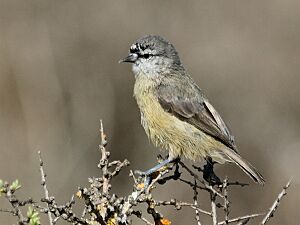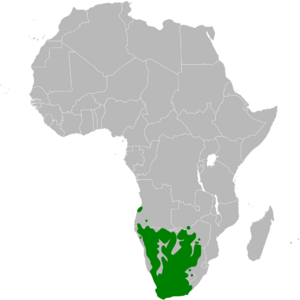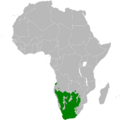Cape penduline tit facts for kids
Quick facts for kids Cape penduline tit |
|
|---|---|
 |
|
| Conservation status | |
| Scientific classification | |
| Genus: |
Anthoscopus
|
| Species: |
minutus
|
 |
|
The Cape penduline tit is a tiny bird also known as the southern penduline tit. Its scientific name is Anthoscopus minutus. This bird belongs to the Remizidae family, which includes other penduline tits.
You can find this small bird in several countries in southern Africa. These include Angola, Botswana, Namibia, South Africa, and Zimbabwe. It likes to live in dry places like savannahs and shrublands. It also lives in areas with Mediterranean-style plants. At only about 8 centimeters (3 inches) long, it is one of Africa's smallest birds. Its relatives, the grey penduline tit and the mouse-coloured penduline tit, are also very small.
About the Cape Penduline Tit
The Cape penduline tit was first officially described in 1812. An English scientist named George Shaw gave it the scientific name Sylvia minuta. Later, in 1851, a German bird expert named Jean Cabanis placed it in a new group called Anthoscopus.
The name Anthoscopus comes from ancient Greek words. Anthos means "blossom" or "flower," and skopos means "searcher." So, the name suggests a "flower searcher." The word minutus is Latin and simply means "little," which fits this tiny bird perfectly.
There are three slightly different types, or subspecies, of the Cape penduline tit:
- A. m. damarensis: Found in parts of Angola, Namibia, Botswana, Zimbabwe, and northern South Africa.
- A. m. gigi: Lives in the southern parts of South Africa.
- A. m. minutus: Found in western and southern Namibia, southwestern Botswana, and western and central South Africa.
Life and Habits
Cape penduline tits are known for their amazing nests. They build a round, hanging nest that looks like a ball. They use spider webs from Stegodyphus spiders and soft plant fibers to make it.
Building a Clever Nest
These birds are very smart about protecting their eggs and chicks. Their nest has a special entrance hole on the side. Below the real entrance, they build a fake entrance and a blind chamber. This means it's a dead end!
The actual entrance to the nest chamber is at the top of a small spout. When the bird leaves the nest, it uses its forehead to push up a special flap. This flap closes the real entrance. This way, only the fake entrance is visible. This clever trick helps protect the nest from predators like snakes. A predator might enter the blind chamber and not find the real nest.
Images for kids




